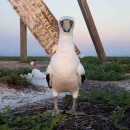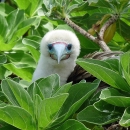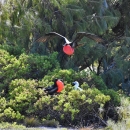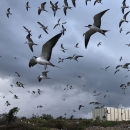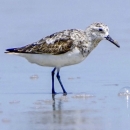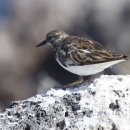Seasons of Wildlife
Due to its location in the Pacific, shore and seabirds can be found nesting year-round at Rose Atoll National Wildlife Refuge. Green sea turtle and hawksbill turtles can be seeing foraging off the throughout the lagoon on Rose Atoll too.
Featured Species
Rose Atoll National Wildlife Refuge is home ot numerous species of unique wildlife. The coral communities of Rose include about 100 species that are distinctive and different than other islands in Samoa. The biodiversity of the atoll teems with fish, seaturtles, and seabirds.
Fish
To date, about 270 species of fish have been recorded and surveys have indicated little change in the reef fish community in the past 15 years. Pelagic fish species found outside the lagoon include various species of tuna, barracuda, mahimahi, billfish, and sharks. Deep diving submersible surveys in 2005 sponsored by the Hawaii Undersea Research Laboratory and U.S. Fish and Wildlife Service revealed a plethora of species and life forms not observed at shallow depths including tunicates, stalked crinoids, many fish, and unusual sea stars. One new species of cardinal fish (Ostorhinchus leslie) was recently discovered at the atoll in the shallow part of the lagoon. The fish assemblages at Rose also differ from the rest of the archipelago by having a much lower density of herbivorous fishes (especially parrotfishes and damselfishes) and a high density of planktivorous and carnivorous fishes (especially unicornfishes and snappers).
Coral
Coral communities at Rose Atoll are distinct from reefs around the other islands in Samoa. The fringing reef is a striking pink hue due to the crustose coralline algae (CCA) that is the primary reefbuilding species at the atoll. The CCA reef plays a significant role at the atoll, stabilizing the perimeter and protecting the lagoon and islands from ocean swells. Unlike the rest of the Samoan Archipelago where they are harvested by humans, the spectacularly colored faisua (giant clams) are found in high densities at the Refuge. Similarly, fish density is very high and species diversity moderately high when compared to other reefs in the Samoan Archipelago.
Reptiles
The two islands at Rose Atoll are important nesting sites for the endangered green turtle in American Samoa. Satellite tags attached to the nesting green turtles at Rose have shown that these turtles migrate between American Samoa and other Pacific island nations including Western Samoa, Fiji, and French Polynesia. The breeding season for green turtles at Rose Atoll is from August through March. They mate in the lagoon and surrounding ocean and the females come on land to lay 50-100 eggs. A female green turtles may lay as many as 5 clutches in a year, but after that she may not return to mate for 3 to 5 years.
Endangered hawksbill turtles have also been seen in the lagoon. These are mostly juvenile turtles and it is unlikely that hawksbill turtles nest on the islands.
Seabirds
Seabirds and migratory shorebirds are the numerically dominant terrestrial vertebrates at Rose Atoll. It is the most important seabird colony in the region, since practically all other islands in the vicinity have been colonized by humans and their commensal mammals such as rats, dogs, cats, and pigs, all of which are incompatible with most breeding seabird populations. The two islands provide important nesting and roosting habitat for 12 species of seabirds protected by the Migratory Bird Treaty Act of 1918, including terns, noddies, boobies, frigatebirds, and tropicbirds.





